FORD F150 2012 12.G Owners Manual
Manufacturer: FORD, Model Year: 2012, Model line: F150, Model: FORD F150 2012 12.GPages: 462, PDF Size: 3.26 MB
Page 161 of 462
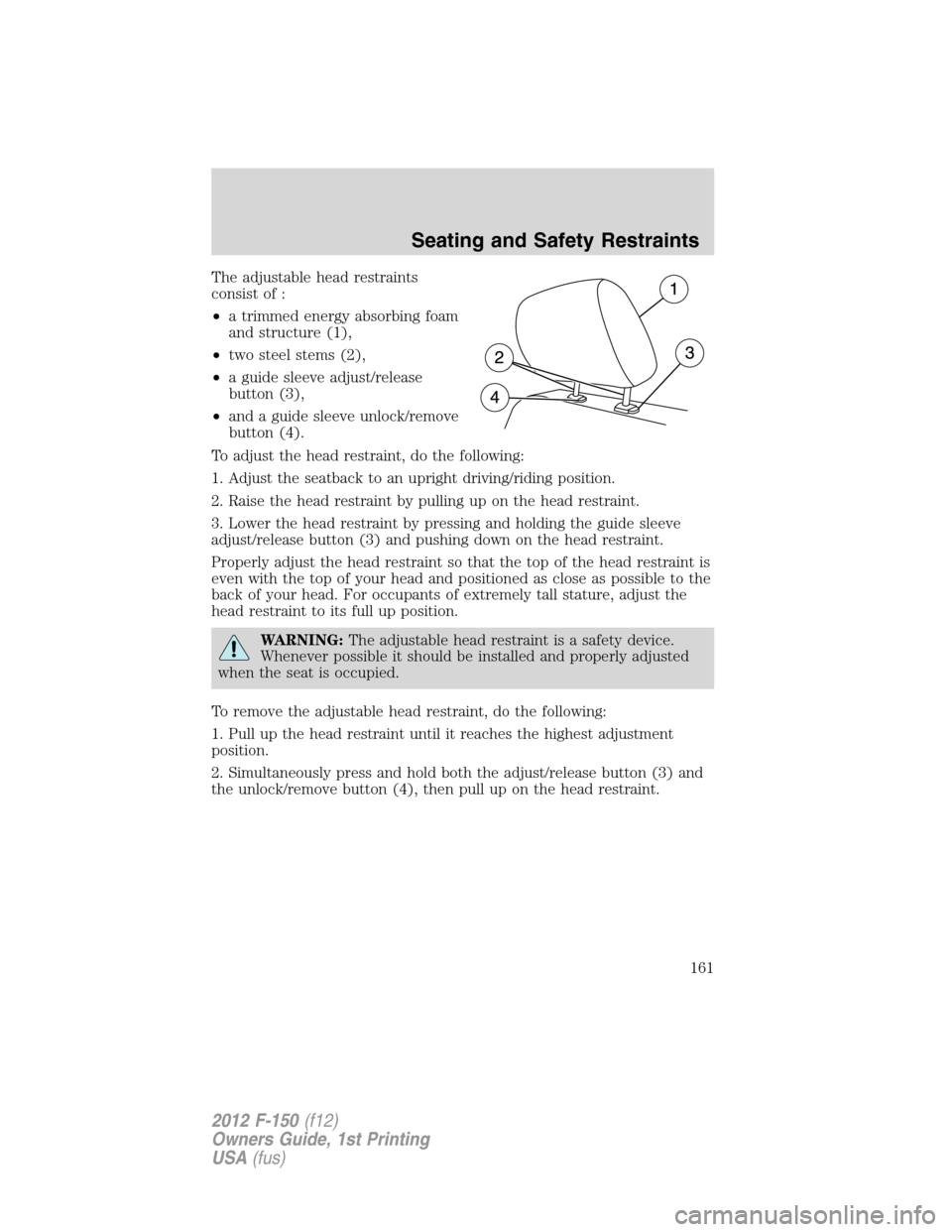
The adjustable head restraints
consist of :
•a trimmed energy absorbing foam
and structure (1),
•two steel stems (2),
•a guide sleeve adjust/release
button (3),
•and a guide sleeve unlock/remove
button (4).
To adjust the head restraint, do the following:
1. Adjust the seatback to an upright driving/riding position.
2. Raise the head restraint by pulling up on the head restraint.
3. Lower the head restraint by pressing and holding the guide sleeve
adjust/release button (3) and pushing down on the head restraint.
Properly adjust the head restraint so that the top of the head restraint is
even with the top of your head and positioned as close as possible to the
back of your head. For occupants of extremely tall stature, adjust the
head restraint to its full up position.
WARNING:The adjustable head restraint is a safety device.
Whenever possible it should be installed and properly adjusted
when the seat is occupied.
To remove the adjustable head restraint, do the following:
1. Pull up the head restraint until it reaches the highest adjustment
position.
2. Simultaneously press and hold both the adjust/release button (3) and
the unlock/remove button (4), then pull up on the head restraint.
Seating and Safety Restraints
161
2012 F-150(f12)
Owners Guide, 1st Printing
USA(fus)
Page 162 of 462
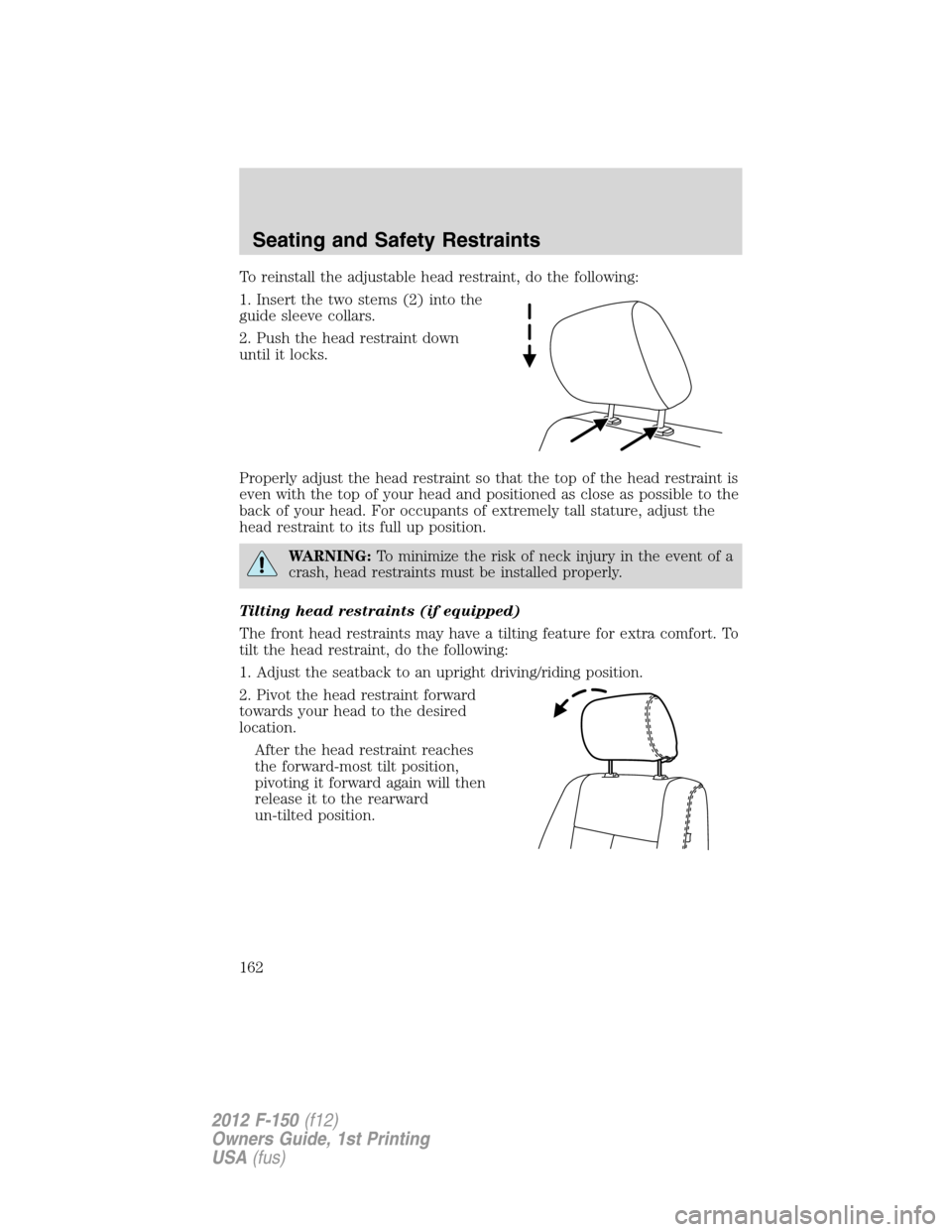
To reinstall the adjustable head restraint, do the following:
1. Insert the two stems (2) into the
guide sleeve collars.
2. Push the head restraint down
until it locks.
Properly adjust the head restraint so that the top of the head restraint is
even with the top of your head and positioned as close as possible to the
back of your head. For occupants of extremely tall stature, adjust the
head restraint to its full up position.
WARNING:To minimize the risk of neck injury in the event of a
crash, head restraints must be installed properly.
Tilting head restraints (if equipped)
The front head restraints may have a tilting feature for extra comfort. To
tilt the head restraint, do the following:
1. Adjust the seatback to an upright driving/riding position.
2. Pivot the head restraint forward
towards your head to the desired
location.
After the head restraint reaches
the forward-most tilt position,
pivoting it forward again will then
release it to the rearward
un-tilted position.
Seating and Safety Restraints
162
2012 F-150(f12)
Owners Guide, 1st Printing
USA(fus)
Page 163 of 462
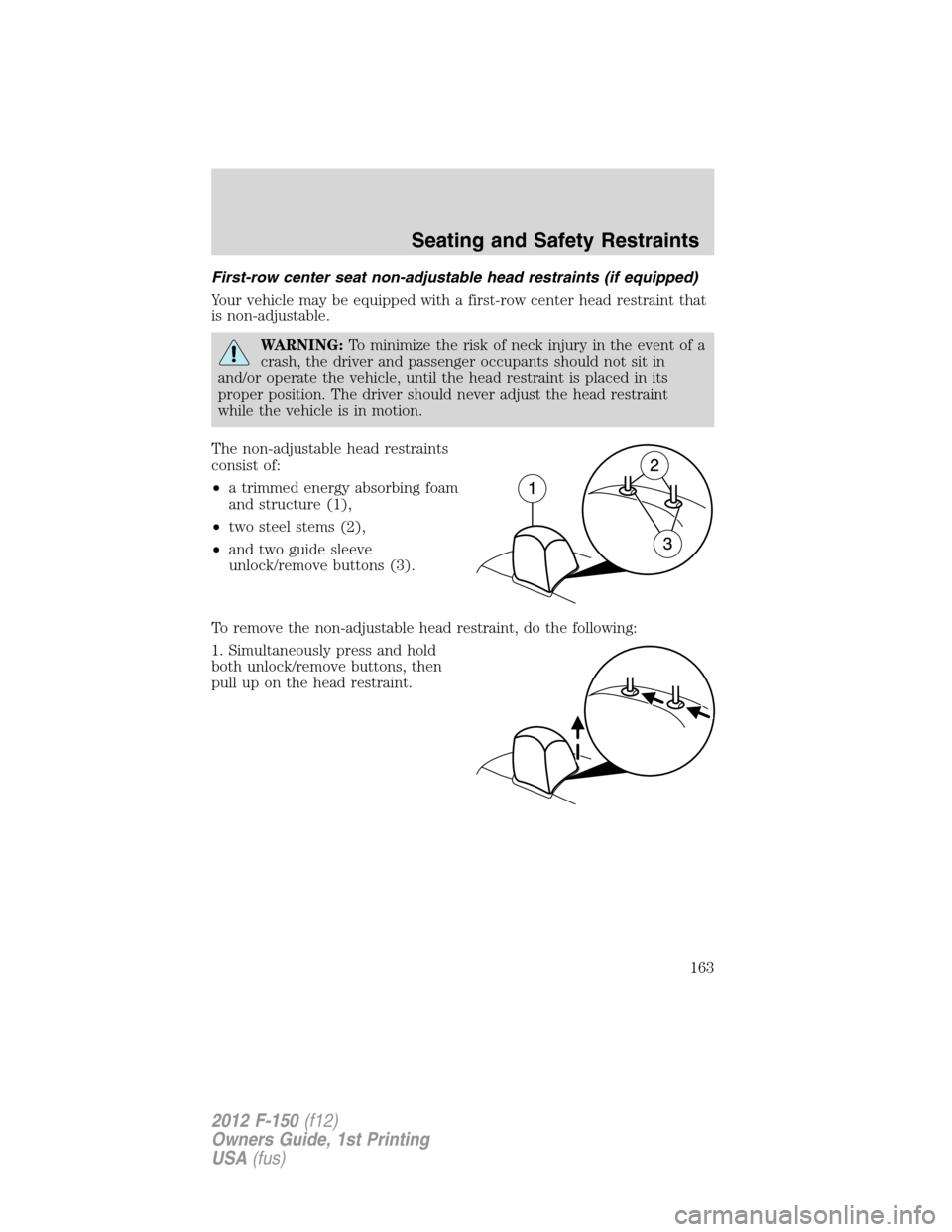
First-row center seat non-adjustable head restraints (if equipped)
Your vehicle may be equipped with a first-row center head restraint that
is non-adjustable.
WARNING:To minimize the risk of neck injury in the event of a
crash, the driver and passenger occupants should not sit in
and/or operate the vehicle, until the head restraint is placed in its
proper position. The driver should never adjust the head restraint
while the vehicle is in motion.
The non-adjustable head restraints
consist of:
•a trimmed energy absorbing foam
and structure (1),
•two steel stems (2),
•and two guide sleeve
unlock/remove buttons (3).
To remove the non-adjustable head restraint, do the following:
1. Simultaneously press and hold
both unlock/remove buttons, then
pull up on the head restraint.
Seating and Safety Restraints
163
2012 F-150(f12)
Owners Guide, 1st Printing
USA(fus)
Page 164 of 462
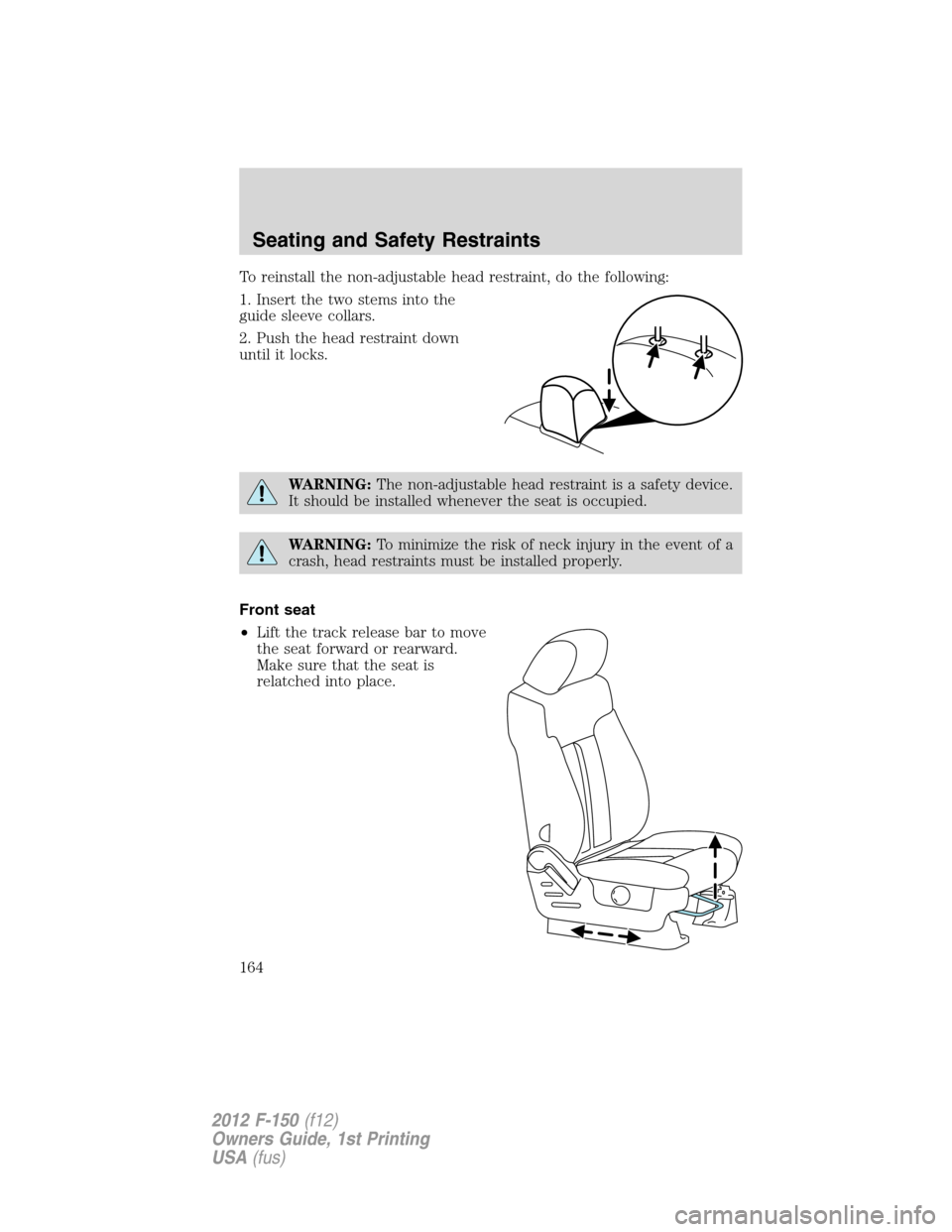
To reinstall the non-adjustable head restraint, do the following:
1. Insert the two stems into the
guide sleeve collars.
2. Push the head restraint down
until it locks.
WARNING:The non-adjustable head restraint is a safety device.
It should be installed whenever the seat is occupied.
WARNING:To minimize the risk of neck injury in the event of a
crash, head restraints must be installed properly.
Front seat
•Lift the track release bar to move
the seat forward or rearward.
Make sure that the seat is
relatched into place.
Seating and Safety Restraints
164
2012 F-150(f12)
Owners Guide, 1st Printing
USA(fus)
Page 165 of 462
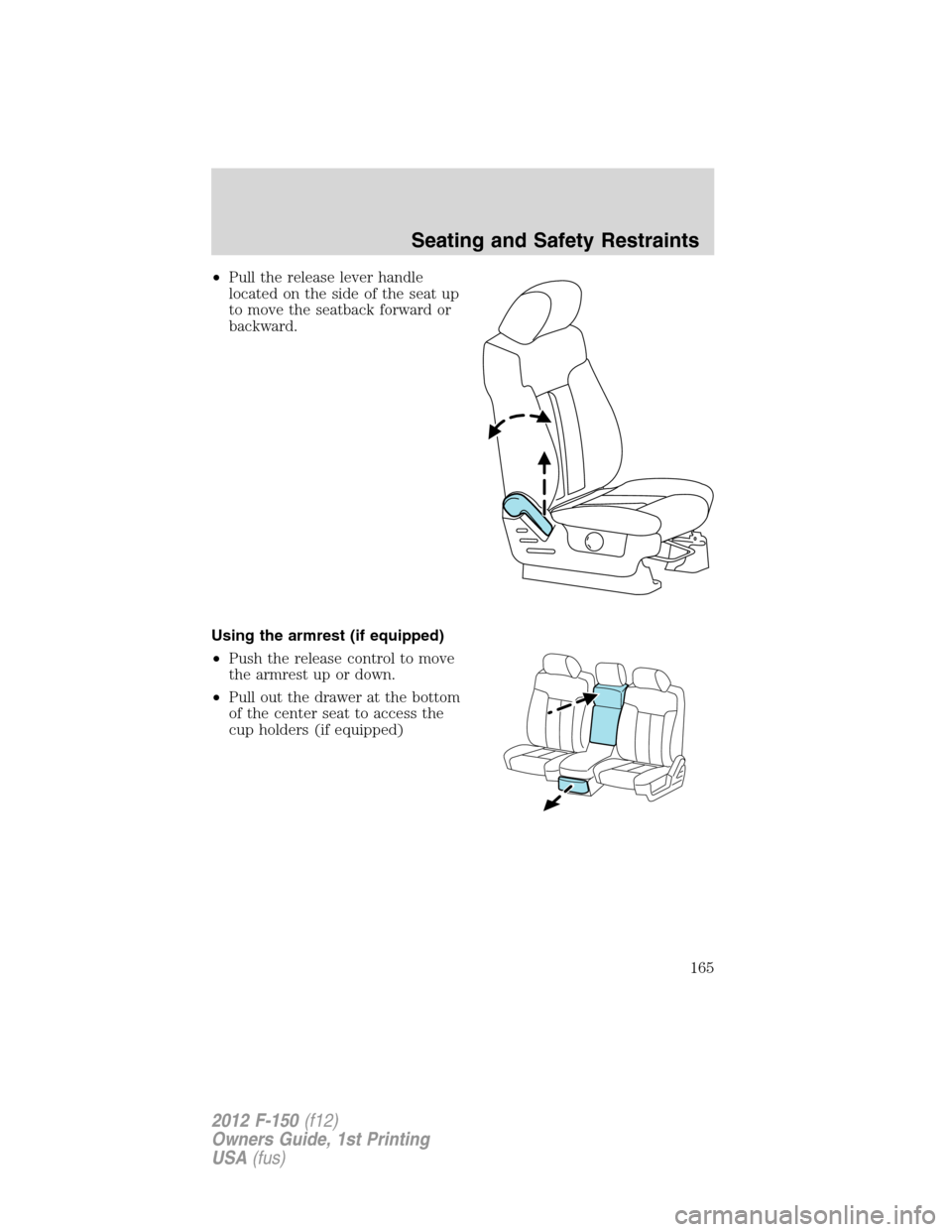
•Pull the release lever handle
located on the side of the seat up
to move the seatback forward or
backward.
Using the armrest (if equipped)
•Push the release control to move
the armrest up or down.
•Pull out the drawer at the bottom
of the center seat to access the
cup holders (if equipped)
Seating and Safety Restraints
165
2012 F-150(f12)
Owners Guide, 1st Printing
USA(fus)
Page 166 of 462

•To gain access to the storage
compartment (if equipped) under
the center seat cushion, lift the
latch to open the lid.
Using the manual lumbar support (if equipped)
For more lumbar support, turn the
lumbar support control toward the
front of vehicle.
For less lumbar support, turn the
lumbar support control toward the
rear of vehicle.
Seating and Safety Restraints
166
2012 F-150(f12)
Owners Guide, 1st Printing
USA(fus)
Page 167 of 462
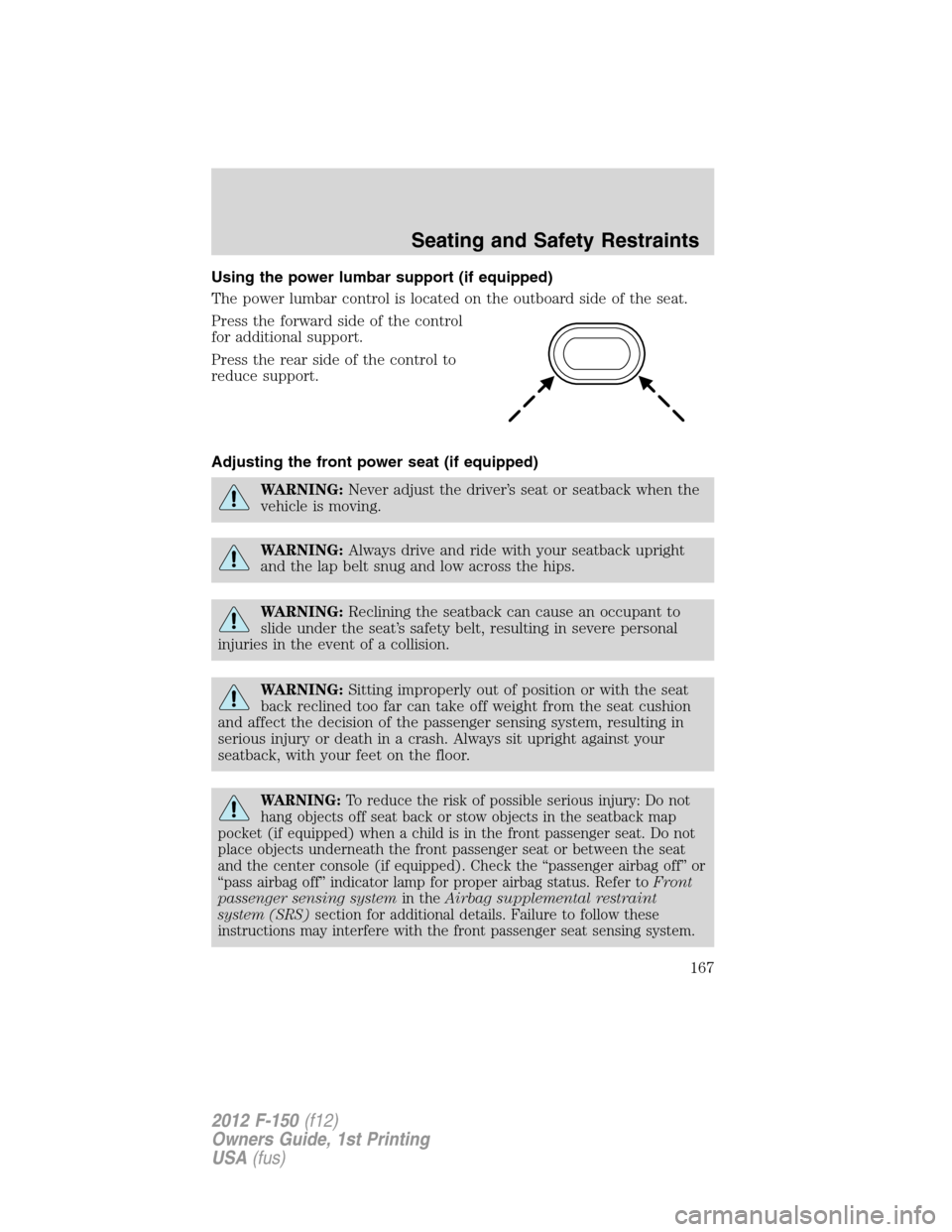
Using the power lumbar support (if equipped)
The power lumbar control is located on the outboard side of the seat.
Press the forward side of the control
for additional support.
Press the rear side of the control to
reduce support.
Adjusting the front power seat (if equipped)
WARNING:Never adjust the driver’s seat or seatback when the
vehicle is moving.
WARNING:Always drive and ride with your seatback upright
and the lap belt snug and low across the hips.
WARNING:Reclining the seatback can cause an occupant to
slide under the seat’s safety belt, resulting in severe personal
injuries in the event of a collision.
WARNING:Sitting improperly out of position or with the seat
back reclined too far can take off weight from the seat cushion
and affect the decision of the passenger sensing system, resulting in
serious injury or death in a crash. Always sit upright against your
seatback, with your feet on the floor.
WARNING:To reduce the risk of possible serious injury: Do not
hang objects off seat back or stow objects in the seatback map
pocket (if equipped) when a child is in the front passenger seat. Do not
place objects underneath the front passenger seat or between the seat
and the center console (if equipped). Check the “passenger airbag off” or
“pass airbag off” indicator lamp for proper airbag status. Refer toFront
passenger sensing systemin theAirbag supplemental restraint
system (SRS)section for additional details. Failure to follow these
instructions may interfere with the front passenger seat sensing system.
Seating and Safety Restraints
167
2012 F-150(f12)
Owners Guide, 1st Printing
USA(fus)
Page 168 of 462

The control is located on the outboard side of the seat cushion.
Move the switch to raise or lower
the front or rear portion of the seat
cushion.
Move the switch to move the seat
forward, backward, up or down.
Power recline (if equipped)
Move the switch to recline the
seatback forward or rearward.
Memory seat/power mirrors/adjustable pedals/steering column
(if equipped)
This system allows automatic
positioning of the driver seat, power
mirrors, adjustable pedals, and
steering column to two
programmable positions.
The memory seat control is located
on the driver’s seat.
•To program position 1, move the
memory features to the desired
positions using the associated
controls. Press and hold button 1 for at least two seconds. A chime
will sound confirming that a memory position has been set.
•To program position 2, repeat the previous procedure using button 2.
Seating and Safety Restraints
168
2012 F-150(f12)
Owners Guide, 1st Printing
USA(fus)
Page 169 of 462
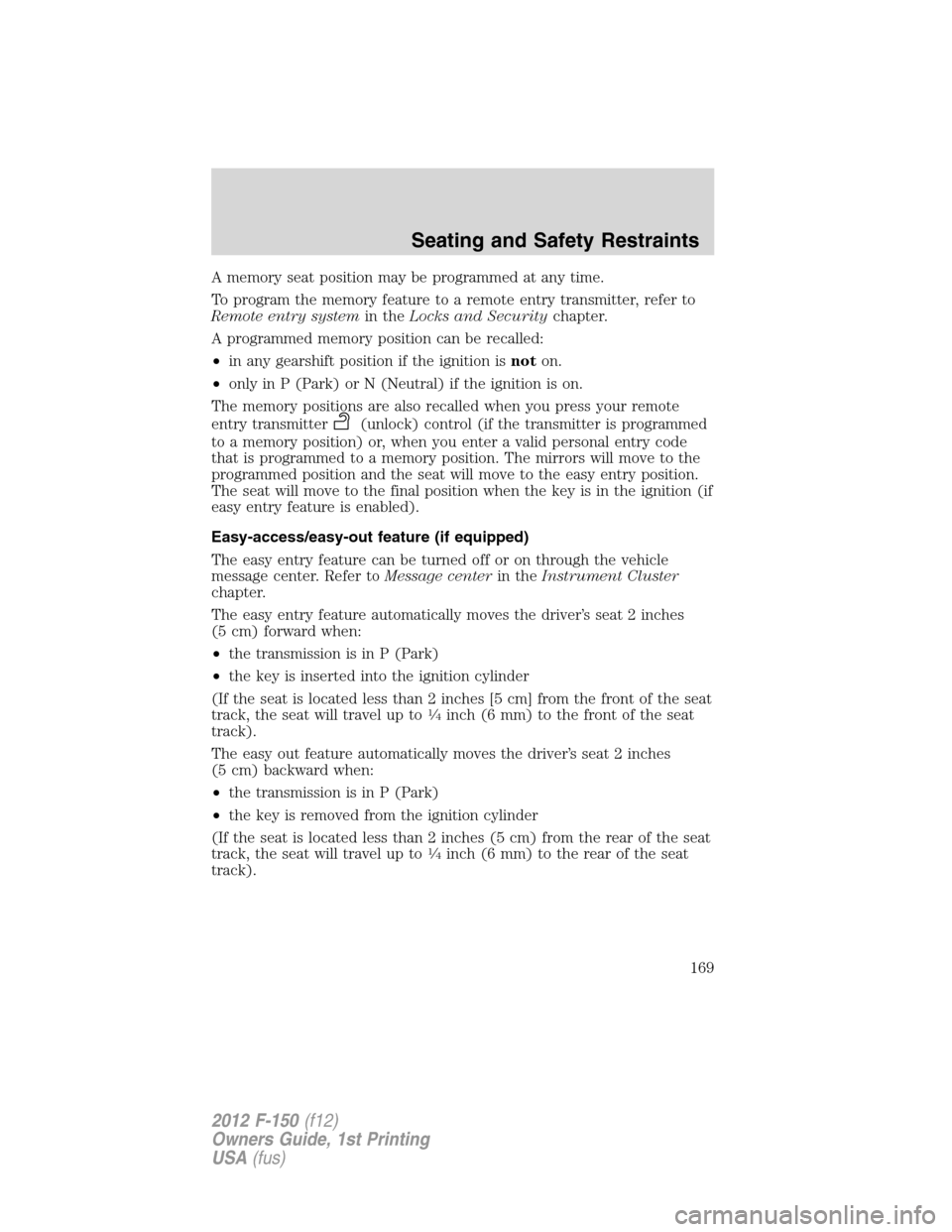
A memory seat position may be programmed at any time.
To program the memory feature to a remote entry transmitter, refer to
Remote entry systemin theLocks and Securitychapter.
A programmed memory position can be recalled:
•in any gearshift position if the ignition isnoton.
•only in P (Park) or N (Neutral) if the ignition is on.
The memory positions are also recalled when you press your remote
entry transmitter
(unlock) control (if the transmitter is programmed
to a memory position) or, when you enter a valid personal entry code
that is programmed to a memory position. The mirrors will move to the
programmed position and the seat will move to the easy entry position.
The seat will move to the final position when the key is in the ignition (if
easy entry feature is enabled).
Easy-access/easy-out feature (if equipped)
The easy entry feature can be turned off or on through the vehicle
message center. Refer toMessage centerin theInstrument Cluster
chapter.
The easy entry feature automatically moves the driver’s seat 2 inches
(5 cm) forward when:
•the transmission is in P (Park)
•the key is inserted into the ignition cylinder
(If the seat is located less than 2 inches [5 cm] from the front of the seat
track, the seat will travel up to
1�4inch (6 mm) to the front of the seat
track).
The easy out feature automatically moves the driver’s seat 2 inches
(5 cm) backward when:
•the transmission is in P (Park)
•the key is removed from the ignition cylinder
(If the seat is located less than 2 inches (5 cm) from the rear of the seat
track, the seat will travel up to
1�4inch (6 mm) to the rear of the seat
track).
Seating and Safety Restraints
169
2012 F-150(f12)
Owners Guide, 1st Printing
USA(fus)
Page 170 of 462
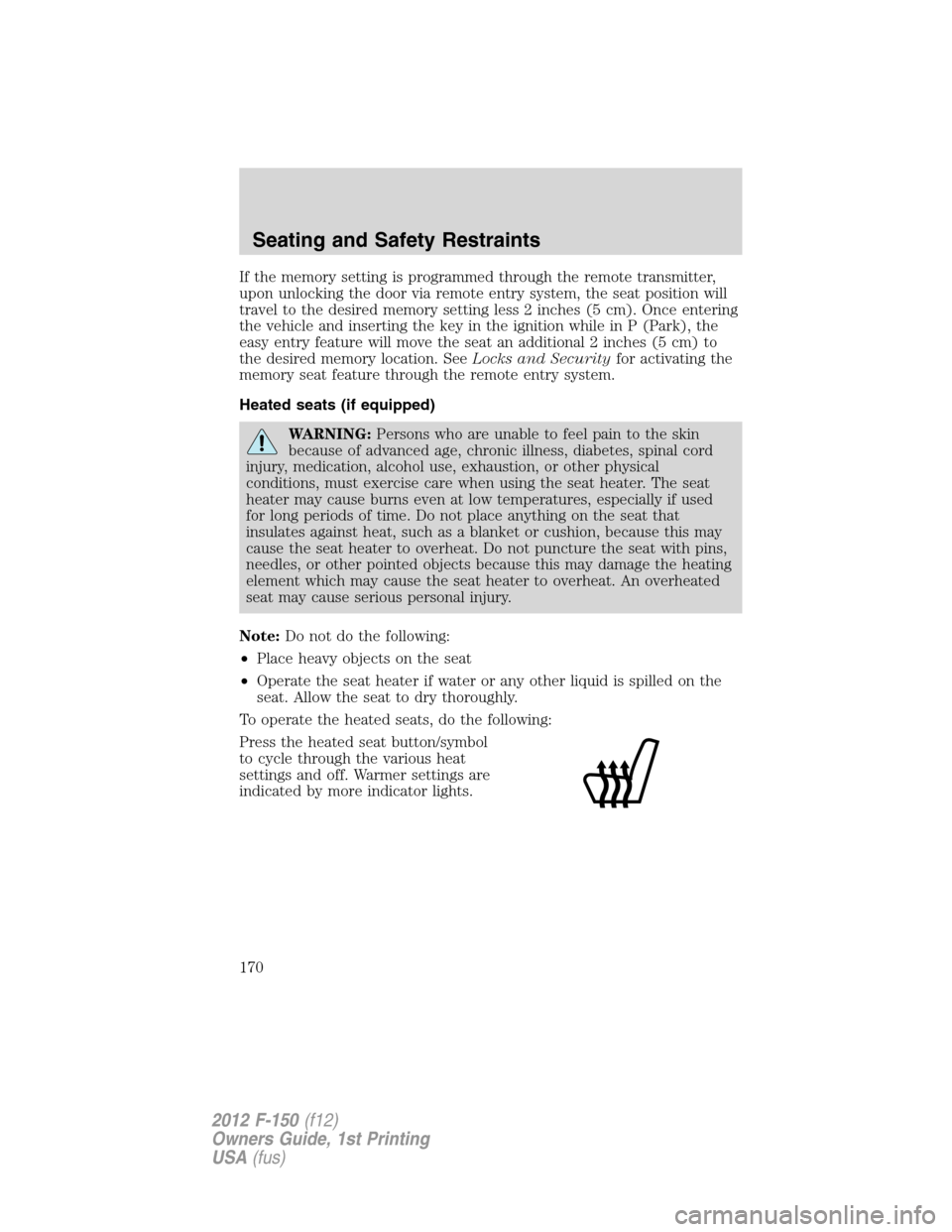
If the memory setting is programmed through the remote transmitter,
upon unlocking the door via remote entry system, the seat position will
travel to the desired memory setting less 2 inches (5 cm). Once entering
the vehicle and inserting the key in the ignition while in P (Park), the
easy entry feature will move the seat an additional 2 inches (5 cm) to
the desired memory location. SeeLocks and Securityfor activating the
memory seat feature through the remote entry system.
Heated seats (if equipped)
WARNING:Persons who are unable to feel pain to the skin
because of advanced age, chronic illness, diabetes, spinal cord
injury, medication, alcohol use, exhaustion, or other physical
conditions, must exercise care when using the seat heater. The seat
heater may cause burns even at low temperatures, especially if used
for long periods of time. Do not place anything on the seat that
insulates against heat, such as a blanket or cushion, because this may
cause the seat heater to overheat. Do not puncture the seat with pins,
needles, or other pointed objects because this may damage the heating
element which may cause the seat heater to overheat. An overheated
seat may cause serious personal injury.
Note:Do not do the following:
•Place heavy objects on the seat
•Operate the seat heater if water or any other liquid is spilled on the
seat. Allow the seat to dry thoroughly.
To operate the heated seats, do the following:
Press the heated seat button/symbol
to cycle through the various heat
settings and off. Warmer settings are
indicated by more indicator lights.
Seating and Safety Restraints
170
2012 F-150(f12)
Owners Guide, 1st Printing
USA(fus)